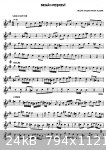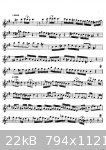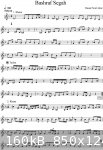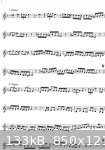Jono Oud N.Z
Oud Junkie
    
Posts: 1119
Registered: 12-14-2009
Member Is Offline
|
|
More on Hijaz and Hijaz Kar
Recently I posted some comments on an interesting modulation in maqam Hijaz.
I know that in Turkish music Hijaz is notated and played with a higher minor second and a lower third than the equal tempered one.
And many agree that the same or similar approach should be applied to Hijaz in Arabic music.
Obviously one needs to make allowance for Western intonation when playing with equal tempered instruments like the saxophone etc. I have heard the
same compromises made in Turkish music that features the Western instruments too (one recording features piano and Turkish oud).
Anyway...
I was reading through the Makam Guide by Murat Aydemir about the seyir (sayr) and intonation of Hijaz Kar.
I noticed that the third is Segah not Buselik, and the second is raised too (Db + 1 comma).
Here is a famous Syrian Samai Hijaz Kar by Nadim Darwish that features a d# that leads to an E.
This is fine, although it would make more sense if the D# resolved to E/b (Sikah).
This would also make the intonation identical to the Turkish theory.
There is also a very interesting modulation to what is either Sikah (or Huzzam) on A/b with D# as a 'color' tone or possibly Awj Ara on E/b?
The third in Rast and Hijaz Kar is the same in Turkish music.
Attachment: samai_hijazkar_Nadim_al-darwish.pdf (109kB)
This file has been downloaded 287 times
|
|
|
spartan
Oud Junkie
    
Posts: 207
Registered: 11-30-2007
Location: Athens , Greece
Member Is Offline
|
|
Excellent approach.
There are different traditions of these maqams .
But I think Hijaz is not played tempered nowhere, it's a european influence.
Usually the Eb is played higher than the European and of course F# lower.
The question is how much lower or higher?
The answer I think is : It depends of the local-ethnic tradition.
(sometimes Eb is so much high, that's close to Segah note)
In my opinion the important is to approach the beautiful Hijaz feeling and mood.
Hijazkar is more clear I think
In Arabic music E is Buselic note, like european
But I dont know if it's a european influence or not.
In Greek, Turkish, Armenian tradition the hijazkar is played with E like Segah note.
There are some great Hijazkar taqsims in arabic style
Qassabji from the old school
I think the modulation you mention on Nadim Darwish is Segah on Sol (newa note), not so sure!
|
|
|
Jono Oud N.Z
Oud Junkie
    
Posts: 1119
Registered: 12-14-2009
Member Is Offline
|
|
Hi.
Yes I agree.
I am pretty sure the Andalusian school play Hijaz close to Western tuning, and they do not use many microtones (Morocco and Algeria).
But as far as the Ottoman tradition goes I agree that most of the different ethnic groups played Hijaz with Segah (in context) as the third, (probably
including the Eastern Arab countries in the Empire too).
The composition by the Syrian Nadim Darwish does seem to point to this conclusion also.
I have done some research on Ottoman intonation from the 16th and 17th centuries.
It seems that the second was played as a neutral tone (Segah) in both Hijaz and Nakriz maqamat during these earlier times.
This is an obvious influence from Persian music (Dastgah Homayun), as many Persians were very influential in early Ottoman music.
The old fretting of the Ottoman tanbur is identical to the modern Persian setar, and the extra intervals were added sometime during the 1700's.
I love the early recordings
|
|
|
spartan
Oud Junkie
    
Posts: 207
Registered: 11-30-2007
Location: Athens , Greece
Member Is Offline
|
|
About modulations on Hijaz maqam based on classical repertoire...
Sometimes there is a 2nd consecutive Hijaz tetrachord on A.
Like Shehnaz maqam.
For example the 3rd hanna of Yusuf Pasha Semai :
http://neyzen.com/nota_arsivi/02_klasik_eserler/034_hicaz/hicaz_ss_...
sometimes I notice a modulation like this :
E (buselik)- F# (Hijaz)-G (Newa)- A (Husseyni)- B (quarter Evic)
If the Newa note is the strong here is like Rast from G ?
Even in folk dances is popular this modulation :
http://www.issaboulos.com/archive/scores/Mandra.pdf
Is this modulation Rast from Newa note (G) ?
|
|
|
fadel
Oud Junkie
    
Posts: 875
Registered: 6-5-2007
Location: saudi arabia
Member Is Offline
Mood: No Mood
|
|
hi
jono ,, I like you work
http://www.youtube.com/watch?v=emxHxe5KQmc
|
|
|
Jono Oud N.Z
Oud Junkie
    
Posts: 1119
Registered: 12-14-2009
Member Is Offline
|
|
Hi.
Yes it seems that in Shanaz and Hijaz Kar that often the upper jins in Buselik the first time round, and Hijaz the second time (but sometimes the
Buselik jins is absent altogether).
It seems that the Buselik upper part is an extension of the Hijaz jins on 5 (Huseyni=Shanaz, Nawa=Hijaz Kar).
The Rast modulation is built into the main Hijaz maqam, but this is different in Iraq, when the fifth is the dominant: Hijaz Diwan (diwan=5).
I play that Mandra very often, it is a very good piece.
(The Awj note needs to replace the B natural (Mahur) note though.)
|
|
|
Jono Oud N.Z
Oud Junkie
    
Posts: 1119
Registered: 12-14-2009
Member Is Offline
|
|
Hi Fadel.
Thank you . .
It is very interesting learning about all of this.
I will have a look at the video.
|
|
|
Jono Oud N.Z
Oud Junkie
    
Posts: 1119
Registered: 12-14-2009
Member Is Offline
|
|
That Simon Shaheen video is amazing!!
I love his playing, he was one of my first influences on the oud.
One of the best!!
Thank you for showing me this one.
|
|
|
luan
Oud Junkie
    
Posts: 157
Registered: 11-25-2011
Member Is Offline
|
|
This is great info.
Where I can get more information about how to tune the notes in each maqam?
Since I'm asking, where can I get how to approach maqams and their notes in taqsims? the order you can play each note?
Thanks a lot!!
|
|
|
Danielo
Oud Junkie
    
Posts: 365
Registered: 7-17-2008
Location: Paris
Member Is Offline
Mood: No Mood
|
|
Hi Jono,
It is funny that we are puzzled by the same issues, and read the same sources  (Murat Aydemir guide is very useful, even though there are some inconsistencies)
(Murat Aydemir guide is very useful, even though there are some inconsistencies)
About the HijazKar semai, I'm puzzled too by the modulation in the third Hane. But it might be simply an imprecision in the music notation (do we have
other sources for this score?).
I recently came across a similar issue with the famous Nihavent Semai of Mesut Cemil.
According to the Arabic transcription found here :
http://www.issaboulos.com/archive/index.php
the third Hane starts with a rather obscure maqam on Busalik. If you look at the Turkish version here :
http://www.neyzen.com/nihavend.htm
this sentence is clearly in Makam EvcAra /Zirguleli Hicaz transposed on Segah.
The origin of these ambiguities is probably that, for Syrian hears, the Turkish Segah degree sounds almost like levantine Buselik and are transcribed
accordingly..
Quote: Originally posted by Jono Oud N.Z  |
Here is a famous Syrian Samai Hijaz Kar by Nadim Darwish that features a d# that leads to an E.
This is fine, although it would make more sense if the D# resolved to E/b (Sikah).
This would also make the intonation identical to the Turkish theory.
There is also a very interesting modulation to what is either Sikah (or Huzzam) on A/b with D# as a 'color' tone or possibly Awj Ara on E/b?
The third in Rast and Hijaz Kar is the same in Turkish music.
|
|
|
|
Jono Oud N.Z
Oud Junkie
    
Posts: 1119
Registered: 12-14-2009
Member Is Offline
|
|
Hi.
Very happy about the interest in this subject . .
I will get back soon.
|
|
|
Jono Oud N.Z
Oud Junkie
    
Posts: 1119
Registered: 12-14-2009
Member Is Offline
|
|
| Quote: |
Where I can get more information about how to tune the notes in each maqam? Since I'm asking, where can I get how to approach maqams and their notes
in taqsims? the order you can play each note?
|
Good question.
Here is a good Turkish site, it shows the seyir and notes of many maqamat.
If you know the names of the notes, Rast, Dugah, Segah etc..
this is a good site.
http://www.eksd.org.tr/turk_sanat_muzigi/makamlar.php
Also I find playing along with recordings helpful and just listening to heaps of maqam based music too.
I chose to use the Syrian intonation for the 'quarter tones', as it is in between Egyptian and Turkish, and represents the old intonation the best in
my opinion.
|
|
|
Jono Oud N.Z
Oud Junkie
    
Posts: 1119
Registered: 12-14-2009
Member Is Offline
|
|
| Quote: |
About the HijazKar semai, I'm puzzled too by the modulation in the third Hane. But it might be simply an imprecision in the music notation (do we have
other sources for this score?). I recently came across a similar issue with the famous Nihavent Semai of Mesut Cemil. According to the Arabic
transcription found here : http://www.issaboulos.com/archive/index.php the third Hane starts with a rather obscure maqam on Busalik. If you look at the Turkish version here
: http://www.neyzen.com/nihavend.htm this sentence is clearly in Makam EvcAra /Zirguleli Hicaz transposed on Segah. The origin of these ambiguities
is probably that, for Syrian hears, the Turkish Segah degree sounds almost like levantine Buselik and are transcribed accordingly..
|
I see, good point, this modulation makes much more sense in the Turkish score.
Do you know when the new Turkish system replaced the old system that was used before the 1700's?.
These compositions are more recent, and only really make sense with the new system.
For this reason pieces composed before 1700 are much more suited to the Arabic (particularly Syrian) intonation.
(I believe that the intonation from Aleppo is the same as the old Turkish one).
It depends on the maqam of course and the modulations.
(Many more recent pieces in many maqamat are of course easily adaptable too).
|
|
|
Danielo
Oud Junkie
    
Posts: 365
Registered: 7-17-2008
Location: Paris
Member Is Offline
Mood: No Mood
|
|
Hi,
very interesting discussion !
It can be that intonation in Aleppo is similar than the old Turkish one, but it seems that somehow it does not prevent musical exchanges between Syria
and Turkey up to the 20th century.
There are some clues in this article of Scott Marcus. He wrote in particular that "In fact, many nineteenth- and early twentieth-century Syrian musicians and music
scholars received their training in Turkey. 'Ali Darwish, for example, studied at a music institute in Istanbul called Dar al-Alhan (Ibn
Dhurayl)"
I think we should not confuse between two issues :
-one is about different intervalic renderings of the same structure. In this case it is rather easy to move back and forth between intonations of
different traditions (Turkish and Levantine).
-another one is about two different systems that are not fully compatible with each other. In this case, a musical piece that makes sense within one
tradition may not in another one - unlike some distorsion is used whenever it is possible (as an example of this, the second Hane of Tanburi Cemil
Bey's FerahFeza Samai is usually transcribed in Arabic sources as Hijaz, instead of Isfahan/Nisabur).
The quote given above seems to indicate that, at least one century ago, we were in the former case. Nevertheless, in Erlanger's book that was written
under to Ali Darwish' s guidance, the material is mostly compatible with Arabic practice (more precisely, it provides many Turkish maqamat fine-tuned
to Arabic practice).
According to the same article, Ali Darwish had proposed a division of the octave, closely related to the Turkish system, but with different intervalic
structure :
'Ali Darwish recognized five notes per whole step, at the second, fourth, fifth, seventh, and ninth comma positions. He further recognized two
notes within the two half steps, at the second and fourth comma positions. This approach gives 29 notes per octave. Within the whole steps, the second
comma gives the half-sharp, the fourth comma gives the flat, the seventh comma gives the half flat, and the ninth comma gives the natural note
position."
Maybe a more complete exposition of this system would solve the puzzle ?
best,
Dan
|
|
|
Jono Oud N.Z
Oud Junkie
    
Posts: 1119
Registered: 12-14-2009
Member Is Offline
|
|
Hi.
I am curious if musicians like Ali Darwish and Misrili Ibrahim Efendi changed their intonation when moving between Turkey and Syria and Egypt or not.
Ali Darwish seemed to be moving towards the comma system.
Also, it is of course possible to play many more recent Turkish pieces with Arabic intonation, but as we have discussed, not all the Turkish maqamat
and modulations work when aplied to Arabic intonation.
I was reading in the liner notes to the 'Ianburi Isak' album by Bezmara that in the mid 1700's, the Byzantine comma system was incorporated and
reorganised the maqam system. This was when the 53 notes per-octave scale replaced the medieval 17 note per-octave scale.
For example Hijaz maqamat were previously played D, Ed, F#, G, etc and changed to D, Eb + 1 comma, F# - 1 comma, G..
Also the neutral seconds and thirds were raised to 1 coma flat intervals, changing the nature of the Segah and Rast modes significantly.
There is a debated 2 comma flat interval used in Turkey for Bayati/Ushshaq type maqamat, but this is never written.
This means the Bayati type maqamat (in Turkey) are closer to the Arabic/Persian ones, than are Rast and Segah maqamat.
I am studying the medieval to 1600 period at the moment.
This really links Persian, Arabic and Turkish together.
It is surprising how hard it is to find out about these styles:
1. Ottoman music from Egypt and the Levant pre 1700.
2. Late Medieval Persian music.
3. Safavid music.
4. Persian/Arabic music from Herat.
Also modern styles on both the Turkish oud (late 1800's) and the Persian nay (since mid 1700's), make both modern Turkish and Persian styles sound
less 'Arabic' than they used too.
|
|
|
adamgood
Oud Junkie
    
Posts: 499
Registered: 6-27-2005
Location: Brooklyn, NY
Member Is Offline
Mood: 2.7 koma flat
|
|
Quote: Originally posted by Danielo  |
About the HijazKar semai, I'm puzzled too by the modulation in the third Hane. But it might be simply an imprecision in the music notation (do we have
other sources for this score?). |
I looked closer at Hane 3 today. Think I've wrapped my head around it but it took some time. For Arabic notation it looks to be technically correct
though the A slash flat next to the G# really throws me off. It can better be notated as A natural but this doesn't really get the point across that
it's basically a kind of transposition of makam Evic, down one whole tone. Here is a good example of Turkish 9-koma notation winning the prize 
So half of hane 3 is this weird Evic transposition I've never seen it before and it must be special to the composer (when was Nedim al Darwish alive
actually? Anyone know his dates?). It is Hane 3 after all and the time to show off his chops. Next half of the hane is obviously makam
Kurdilihicazkar.
I re notated the piece to Turkish notation, it's a fun one, check it out. See attached.
Adam
PS please any info on Nedim al Darwish? I don't know anything about him.
Attachment: Hicazkar_saz_semaisi-nedim_al_darwish.pdf (159kB)
This file has been downloaded 270 times
|
|
|
Brian Prunka
Oud Junkie
    
Posts: 2916
Registered: 1-30-2004
Location: Brooklyn, NY
Member Is Offline
Mood: Stringish
|
|
Adam, I'm confused by your confusion!
I don't see any significant difference between your 3rd hane and the Arabic-notated one. The slash-flat in Arabic notation is (more or less)
equivalent to the backwards flat you use . . . what else is different. I understand that the intonation might be slightly different with an Arabic
performer, but the conception of the maqam seems the same, no?
Notating it as A natural would probably be closer to the Turkish Evic in pitch, but not in conception.
I'm not too versed on the Turkish names, an Arab performer would likely call this a modulation to Sikah on A half-flat. IMO, the more confusing thing
is the descending part with F - E - D# - C - Bb - A/b.
|
|
|
Jono Oud N.Z
Oud Junkie
    
Posts: 1119
Registered: 12-14-2009
Member Is Offline
|
|
Thanks for the Turkish transcription.
Nadim Darwish was the son of Ali Darwish (1892-1923).
Ali Dawish was from Aleppo but studied music in Istanbul and brought his knowledge back to Syria.
Ali Darwish was the main informer of Rudolphe D'Erlanger.
He is also responsible for the taqasim examples of maqamat in the D'Erlanger book.
I was wondering if the maqam is Awj Ara (Evcara) on Segah (Ed) and falls to Segah on Tik Hisar (Ad).
This would make more sense with the Turkish raised Segah third than the Buselik one.
(The reason I mention the raised Segah is that if the pitch is played as Segah in Arabic intonation it is too flat for Hijaz type
maqamat).
The third of Hijaz was a major third up till the mid to late 1700's, as recorded in the Cantemir book. (The second was also a neutral second,
but this only exists today in Iran and in Turkish 'Gypsy' music).
The second and third were both flattened, probably to make the large interval sound smoother.
This is related to Byzantine music.
(Sorry if I have repeated myself a bit about this issue).
The Ad going down to E is nasty, the perfect fourth makes much more sense.
Maybe for Arabic style performers, the idea would to play the third (of Hijazkar) as Buselik as normal apart from alternating to Segah in the third
Khana.
|
|
|
Brian Prunka
Oud Junkie
    
Posts: 2916
Registered: 1-30-2004
Location: Brooklyn, NY
Member Is Offline
Mood: Stringish
|
|
This makes some sense, I think the same issue happens with B natural vs. B half flat in the lower octave of huzam, the lower tetrachord: E/b D# C B
It seems the B is played very low, close to B/b.
|
|
|
Jono Oud N.Z
Oud Junkie
    
Posts: 1119
Registered: 12-14-2009
Member Is Offline
|
|
Good point.
The notes change according to the jins and whether ascending or descending.
This is a good example of the jins being more crucial than the scale.
|
|
|
adamgood
Oud Junkie
    
Posts: 499
Registered: 6-27-2005
Location: Brooklyn, NY
Member Is Offline
Mood: 2.7 koma flat
|
|
Quote: Originally posted by Brian Prunka  | Adam, I'm confused by your confusion!
*snip*
I'm not too versed on the Turkish names, an Arab performer would likely call this a modulation to Sikah on A half-flat. IMO, the more confusing thing
is the descending part with F - E - D# - C - Bb - A/b.
|
Brian the Arabic notation for the piece is indeed spot on, I was just thrown initially by two things:
1. My Arabic notation reading sucks, I never work on it.
2. Actually that's just it, my reading is not good for Arabic notation. Just took me a long time to figure out what the heck was going on.
But what is the confusing part about "F - E - D# - C - Bb - A/b" ?
The E? Here I do disagree with the notation, it should be E/b
Anyway as I said this is a somewhat weird transposition of some cesni to an atypical place (I haven't seen it before). I mentioned it's like
Evic...maybe a little bit, maybe a little like Ferahnak, it has some of those cesnis (in the end it's just nice melodies) but Evcara no, for that
you'd need:
D# - E - F - E/b - D - C# - Bb - A/b
Or something like that (zirgule cesni on the bottom)
Forgive me if I'm saying the same thing that you guys are saying already! That's always possible 
|
|
|
Jono Oud N.Z
Oud Junkie
    
Posts: 1119
Registered: 12-14-2009
Member Is Offline
|
|
Interesting...
Maybe the modulations are just moving the related Segah jins around in an interesting way; going between Segah on Ad and Ed, and back to Ad.
Huzzam on Ad from Hijazkar is more common but certainly related.
Nice and interesting modulations.
Check out the modulations in the third khana here:
I am interested in the modulations here, I have a couple of ideas but...
Here are the Turkish and Arabic notations.
They relate to those in the Hijazkar piece.
(By the way, I am using Sibelius and do not have the flats with the slash available, previously I would write them as flats and draw the slashes with
a pen and photocopy, LOL).
(I have edited the transposition again recently too).




|
|
|